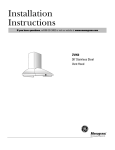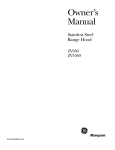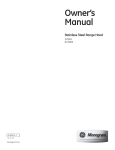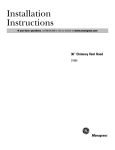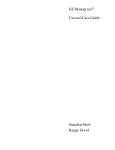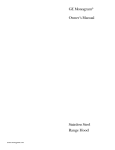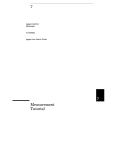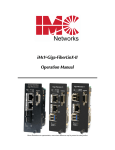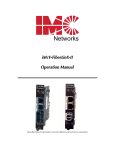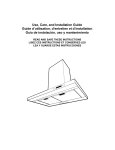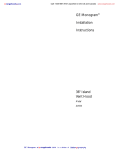Download Monogram ZV925 Owner`s manual
Transcript
Call 1-800-667-8721 anywhere in the US and Canada - www.rangehoods.com at :: rangehoods . com Installation Instructions ZV950 36" Stainless Steel Vent Hood Monogram. ® We bring good things to life. GE Monogram at :: rangehoods . com is a division of kitchen :: accessories U N L I M I T E D Call 1-800-667-8721 anywhere in the US and Canada - www.rangehoods.com Safety Information BEFORE YOU BEGIN WARNING: TO REDUCE THE RISK Read these instructions completely and carefully. • OF FIRE, ELECTRICAL SHOCK OR INJURY TO PERSONS, OBSERVE THE FOLLOWING: A. Use this unit only in the manner intended by the manufacturer. If you have any questions, contact the manufacturer. B. Before servicing or cleaning unit, switch power off at the service panel and lock service panel to prevent power from being switched on accidentally. If the service panel cannot be locked, fasten a tag or prominent warning label to the panel. IMPORTANT - Save these instructions for local inspector’s use. • IMPORTANT - Observe all governing codes and ordinances. • Note to Installer - Be sure to leave these instructions with the Consumer. • Note to Consumer - Keep these instructions with your Owner’s Manual for future reference. • Skill Level – Installation of this appliance requires basic mechanical and electrical skills. • Completion time – 1 to 3 hours. • Proper installation is the responsibility of the installer. Product failure due to improper installation is not covered under the Warranty. ADVERTISSEMENT POUR RÉDUIRE LE RISQUE D’INCENDIE, DE CHOC ÉLECTRIQUE OU DE BLESSURES, IL FAUT OBSERVER LES RÈGLES SUIVANTES : A. Utiliser cet appareil uniquement de la manière prévue par le fabricant. En cas de question, consulter le fabricant. B. Avant toute intervention ou nettoyage, couper l’alimentation électrique au disjoncteur et verrouiller le panneau du disjoncteur pour éviter la mise sous tension accidentelle. S’il n’est pas possible de verrouiller le panneau du disjoncteur, attacher un placard ou une étiquette très visible au panneau. • For general ventilating use only. Do not use to exhaust hazardous or explosive materials or vapors. • Structural framing, installation work and electrical wiring must be done by qualified person(s). In accordance with all applicable codes and standards including fire-rated construction. • Sufficient air is needed for proper combustion and exhausting of gases through the flue (chimney) of fuel burning equipment to prevent back drafting. Follow the heating equipment manufacturer’s guideline and safety standards such as those published by the National Fire Protection Association (NFPA), and the American Society for Heating, Refrigeration and Air Conditioning Engineers (ASHRAE), and the local code authorities. • Local codes vary. Installation electrical connections and grounding must comply with applicable codes. In the absence of local codes, the vent should be installed in accordance with National Electrical Code ANSI/NFPA 70-1990 or latest edition. CAUTION: Due to the weight and size of these vent hoods and to reduce the risk of personal injury or damage to the product, TWO PEOPLE ARE REQUIRED FOR PROPER INSTALLATION. PRUDENCE À cause du poids et de la taille de ces hottes et pour réduire le risque de blessures et de dommages, IL FAUT DEUX PERSONNES POUR FAIRE L’INSTALLATION CORRECTEMENT. WARNING: To reduce the risk of fire or electrical shock, do not use this range hood with any external solid-state speed control device. Any such alteration from original factory wiring could result in damage to the unit and/ or create an electrical safety hazard. ADVERTISSEMENT Pour réduire le risque d’incendie ou de choc électrique, il ne faut pas utiliser cette hotte avec un régulateur de vitesse électronique externe. Toute modification de ce type du branchement d’usine peut endommager l’appareil ou créer un risque de choc électrique. CAUTION: To reduce risk of fire and to properly exhaust air, be sure to duct air outside–Do not vent exhaust air into spaces within walls or ceilings or into attics, crawl spaces, or garages. PRUDENCE–Il faut prendre soin TO REDUCE THE RISK OF FIRE, USE ONLY METAL DUCTWORK. d’installer un conduit vers l’extérieur pour réduire le risque d’incendie et pouvoir évacuer l’air correctement. Il ne faut pas évacuer l’air dans l’espace entre les parois d’un mur, un plafond ou un grenier, un espace sanitaire ou un garage. 2 GE Monogram at :: rangehoods . com is a division of kitchen :: accessories U N L I M I T E D Call 1-800-667-8721 anywhere in the US and Canada - www.rangehoods.com Design Information CONTENTS Ductwork, Wiring Locations ............................................ 7 Installation Instructions Step 1, Install Framing for Hood Support ...................... 8 Step 2, Install Mounting Brackets .................................... 8 Step 3, Install Duct Bracket .............................................. 9 Step 4, Install the Hood ................................................... 9 Step 5, Connect Ductwork ............................................. 10 Step 6, Connect Electrical .............................................. 10 Step 7, Install Duct Covers ............................................. 10 Step 8, Install Filters ....................................................... 11 Step 9, Finalize Installation ............................................ 11 Design Information Product Dimensions and Clearances .............................. 3 Optional Accessories ........................................................ 3 Advance Planning, Ductwork, Framing ......................................................... 4 Power Supply .................................................................... 4 Duct Fittings ...................................................................... 5 Installation Preparation Tools and Materials Required .......................................... 6 Remove the Packaging ..................................................... 6 Check Installation Hardware ........................................... 7 PRODUCT DIMENSIONS AND CLEARANCES *Height to Ceiling Installation Height Depending on Ceiling Height 10" 25" 35-5/8" *The supplied duct cover fits 8 ft. to 10 ft. ceilings. The vent hood must be installed 25-1/2” min. and 30” max. above the cooking surface. Use the decorative duct cover to conceal ductwork running from the top of the hood to the ceiling. The supplied 2-piece duct cover is sized to reach 8 ft. to 10 ft. ceiling heights. 36" Min. Cooking surface to bottom of hood should be: • 25-1/2" max. for 8 ft. ceiling height. • 25-1/2" to 30" for 9 ft. ceiling height. • 30" min. for 10 ft. ceiling height. Plan the installation height carefully to avoid unsightly gaps above the hood. The hood installation height, from the cooking surface to the bottom of the hood, depends upon ceiling height. OPTIONAL ACCESSORIES Note: Duct covers must be installed as shown in this book. Do not “build-in” the duct cover. If service is required, the duct cover must be removed to access hood components. ZX14SDSS, optional stainless steel duct cover is available for ceiling heights greater than 10 ft. and up to 14 ft. Order the optional duct cover at the same time as the vent hood and have on site before installation. 3 GE Monogram at :: rangehoods . com is a division of kitchen :: accessories U N L I M I T E D Call 1-800-667-8721 anywhere in the US and Canada - www.rangehoods.com Installation Preparation ADVANCE PLANNING Ductwork Planning • Determine the exact location of the vent hood. • Plan the route for venting exhaust to the outdoors. • Use the shortest and straightest duct route possible. For satisfactory performance, duct run should not exceed 100 equivalent length for any duct configurations. • Refer to “Duct Fittings” chart to compute the maximum permissible length for duct runs to the outdoors. • Use metal ductwork. These hoods must use 8" round duct. It can transition to 3-1/4" x 12", reducing the maximum equivalent duct length to 75 feet. • Install a wall cap with damper or roof cap at the exterior opening. Order the wall or roof cap and any transition needed in advance. Wall Framing for Adequate Support • This vent hood is heavy. Adequate structural support must be provided. The hood must be secured to vertical studs in the wall, or to a horizontal support. See page 8. • We strongly recommend that the vent hood with duct cover be on site before final framing and wall finishing This will also help to accurately locate the ductwork and electrical service. CAUTION: To reduce risk of fire and to properly exhaust air, be sure to duct air outside–Do not vent exhaust air into spaces within walls or ceilings or into attics, crawl spaces, or garages. PRUDENCE–Il faut prendre soin d’installer un conduit vers l’extérieur pour réduire le risque d’incendie et pouvoir évacuer l’air correctement. Il ne faut pas évacuer l’air dans l’espace entre les parois d’un mur, un plafond ou un grenier, un espace sanitaire ou un garage. POWER SUPPLY • Route house wiring as close to the installation location as possible in the ceiling or soffit. Wiring should enter at least 4" above the bracket on the right side. • Connect the wiring to the house wiring in accordance with local codes. IMPORTANT - (Please read carefully) WARNING: FOR PERSONAL SAFETY, THIS APPLIANCE MUST BE PROPERLY GROUNDED. Grounding instructions The grounding conductor must be connected to a ground metal, permanent wiring system, or an equipment-grounding terminal or lead on the hood. ADVERTISSEMENT POUR DES RAISONS DE SÉCURITÉ, CET APPAREIL DOIT ÊTRE CORRECTEMENT MIS À LA TERRE. WARNING: The improper connection of Remove house fuse or open circuit breaker before beginning installation. the equipment-grounding conductor can result in a risk of electric shock. Check with a qualified electrician or service representative if you are in doubt whether the appliance is properly grounded. Do not use an extension cord or adapter plug with this appliance. Follow National electrical codes or prevailing local codes and ordinances. ADVERTISSEMENT Le mauvais branchement du fil de mise à la terre peut causer un choc électrique. En cas de doute, consulter un électricien qualifié ou un technicien pour déterminer si l’appareil est à la terre. Electrical supply This vent hood must be supplied with 120V, 60Hz, and connected to an individual, properly grounded branch circuit, and protected by a 15 or 20 amp circuit breaker or time delay fuse. • Wiring must be 2 wire with ground. • If the electrical supply does not meet the above requirements, call a licensed electrician before proceeding. 4 GE Monogram at :: rangehoods . com is a division of kitchen :: accessories U N L I M I T E D Call 1-800-667-8721 anywhere in the US and Canada - www.rangehoods.com Installation Preparation DUCT FITTINGS Duct Piece Use this chart to compute maximum permissable lengths for duct runs to outdoors. Note: Do not exceed maximum permissable equivalent lengths! Maximum duct length: 100 foot for 8" round duct 75 foot for 3-1/4" x 12" duct Flexible ducting: If flexible metal ducting is used, all the equivalent feet values in the table should be doubled. The flexible metal duct should be straight and smooth and extended as much as possible. Do NOT use flexible plastic ducting. Equivalent Length* Dimensions Round, straight 1 ft. (per foot length) 3-1⁄4" x 12" or 3-1/4" x 24" straight 1 ft. (per foot length) 8" Round 90° elbow 15 ft. 8" Round 45° elbow 8 ft. 3-1⁄4" x 12" 90° elbow 11 ft. 3-1⁄4" x 12" or 45° elbow 6 ft. 3-1⁄4" x 12" 90° flat elbow 24 ft. 8" round to 3-1⁄4" x 12" or 3-1/4" x 24" transition 1 ft. 3-1⁄4" x 12" to 8" round round transition 8 ft. 8" round to 3-1/4" x 12" or transition 90° elbow 16 ft. Quantity Used Note: Any home ventilation system, such as a ventilation hood, may interrupt the proper flow of combustion air and exhaust required by fireplaces, gas furnaces, gas water heaters and other naturally vented systems. To minimize the chance of interruption of such naturally vented systems, follow the heating equipment manufacturer’s guidelines and safety standards such as those published by NFPA and ASHRAE. This Hood Must Use 8" Round Duct. It Can Transition To 3-1/4" x 12" Duct 3-1⁄4" x 12" to 8" round round transition 90° elbow 17 ft. 8" Round wall cap with damper 30 ft. 3-1⁄4" x 12" wall cap with damper 30 ft. 8" Round roof cap 26 ft. 8" Round roof vent 26 ft. * Actual length of straight duct plus duct fitting equivalent. Equivalent length of duct pieces are based on actual tests conducted by GE Evaluation Engineering and reflect requirements for good venting performance with any ventilation hood. Total Duct Run 5 GE Monogram at :: rangehoods . com is a division of kitchen :: accessories U N L I M I T E D Total Equivalent Length Call 1-800-667-8721 anywhere in the US and Canada - www.rangehoods.com Installation Preparation TOOLS AND MATERIALS REQUIRED (NOT SUPPLIED) • Tape measure • Knife • Spirit level • Wire cutter/stripper • Wire nuts • Electric drill with 1/8" and 3/8" bits • Phillips and flat blade screwdrivers • Hammer • Pliers • Safety glasses • Duct tape • Tape to mount template • Gloves to protect against sharp edges • 120V 60Hz. 15 or 20 Amp, 2 wire with ground. Properly grounded branch circuit. • Strain relief for junction cover. • 8" round metal duct, length to suit installation. REMOVE THE PACKAGING The vent hood is shipped secured to a shipping board with a shipping bracket and 4 screws. • Remove the duct cover, parts box and other packaging. • Lift the hood out of the box. • Remove and properly discard the plastic wrapping. Top Of Hood Junction Box Top Shipping Screws Remove Bottom Shipping Screws and Shipping Bracket Shipping Board • Remove junction box cover. • Install strain relief into junction box cover. • Locate and remove 2 screws at the top of the hood. Remove 2 screws at the bottom behind the filter guides on the left and right sides. Remove the shipping bracket from behind the blower housing. Discard the shipping bracket and board. 6 GE Monogram at :: rangehoods . com is a division of kitchen :: accessories U N L I M I T E D Call 1-800-667-8721 anywhere in the US and Canada - www.rangehoods.com Installation Preparation DUCTWORK, WIRING LOCATIONS CHECK INSTALLATION HARDWARE Determine the exact location of the vent hood. • Locate the template packed with the literature. – Measure 36" from the floor to the top of the cooking surface. Add 25-1/2" (or other recommended space) from the cooking surface to the bottom of the hood. Mark that location. – Use a level to draw a straight pencil line on the wall. Locate the hardware accessory box packed with the hood and check contents. FOR CEILING VENT DUCTING 6-1/4" Centerline To Wall 4 Wall Fasteners 8 Wood Screws 8-1/2" Dia. Hole Centerline 8" Min. Above Top Mounting Bracket Holes FOR WALL VENT DUCT 2-5/32" • Drill 1/8" Pilot Holes For Mounting Brackets. 2 Large Flat Washers 13-9/16" 5-7/8" 2 Mounting Brackets 17-5/16" 3-15/16" CL • Drill 1/8" Pilot Holes. Align edge 25-1/2" above Cooking Surface. • Drill 1/8" Pilot Holes. – Tape the template in position along the penciled line. CHECK TO BE SURE THE TEMPLATE IS LEVEL. 2 Phillips Head Decorative Screws Ceiling ducting: If ductwork will vent straight up to the ceiling: • Use a level to draw a line straight up, from the centerline on the template to the ceiling. • Measure 6-1/4" from the back wall to the centerline of a 8-1/2" hole on the ceiling. 3 Stainless Steel Grease Filters 16" Note: If drywall is not present, add drywall thickness to the 6-1/4" dimension. Wall Ducting: If ductwork will vent to the rear: • Use the level to draw a line straight up from the centerline on the template. • Measure at least 8" above the top mounting bracket holes shown on the template to the centerline of an 8-1/2" dia. duct hole. (Hole may be elongated for duct elbow.) Duct Cover Bracket 24" 23" 2-5/32" • Drill 1/8" Pilot Holes For Mounting Brackets. CL 5-7/8" HOUSE WIRING LOCATION: • The junction box is located on the top of the hood, at the back right side. • Route house wiring as close to the ceiling location as possible; through the ceiling, soffit or back wall. Wiring should enter at least 4" above the bracket on the right side. 13-9/16" CL 11" 17-5/16" CL • Drill 1/8" Pilot Holes. Align edge 25-1/2" above Cooking Surface. 3-15/16" 2-piece Decorative Duct Cover (dimension shown for reference only) • Drill 1/8" Pilot Holes. Wall Mount Template 7 GE Monogram at :: rangehoods . com is a division of kitchen :: accessories U N L I M I T E D Call 1-800-667-8721 anywhere in the US and Canada - www.rangehoods.com Installation Instructions 2 INSTALL MOUNTING BRACKETS 1 INSTALL FRAMING FOR HOOD SUPPORT This vent hood must be secured to the horizontal support or wall studs. IMPORTANT: Framing must be capable of supporting 100 lbs. • With the template taped in place, use a punch to mark all mounting screw locations. • Drill 1/8" pilot holes at the 6 punched locations. • Remove the template. • The 4 support bracket holes must enter studs or the horizontal support. 8" Min. Opening for Ductwork View From Rear Cleats Screws “B” Note: Screws “A” and “B” are pre-assembled onto the brackets. Do not remove these screws. Screws “A” 1" x 6" Min. Mounting Support • The two lower holes can be enlarged if they that did not enter studs to 3/8". Tap anchors for wall fasteners into the bottom holes. – Screws should be inserted by hand into the fasteners to allow anchors to expand against the wall material. Remove the screws for final installation. • Secure the mounting brackets to the wall studs with wood screws provided. Centerline of Installation Space If drywall is present, mark the screw hole locations for the top mounting brackets. Remove the template. • Cutaway enough drywall to expose 2 vertical studs at the bracket location indicated on the template. • Install a horizontal support at least 1" x 6" between two wall studs at the top bracket installation location. The horizontal support must be flush with the room side of the studs. Use cleats behind both sides of the support to secure the support to wall studs. • Reinstall drywall. 8 GE Monogram at :: rangehoods . com is a division of kitchen :: accessories U N L I M I T E D Call 1-800-667-8721 anywhere in the US and Canada - www.rangehoods.com Installation Instructions 3 INSTALL DUCT BRACKET The duct bracket must be installed against the ceiling. This bracket will hold the decorative duct cover in place at the top. • Install the 2 small screws into the sides of the duct bracket. Remove the screws. Pre-tapping the holes will insure ease of final installation. Pre-Tap Side Screw Pre-Tap Side Screw Secure the bracket to the ceiling and wall: • Mark the 4 screw hole locations. • Drill 1/8" pilot holes in marked bracket location. • If pilot holes do not enter studs, enlarge the holes to 3/8" and install wall fastener anchors. • Drive screws, by hand, into the fasteners to allow anchors to expand. Remove the screws. • Secure the bracket to the ceiling and wall with wood screws and/or fasteners. 4 INSTALL THE HOOD Bracket Tabs Place the hood on the brackets and slide left to right to align with rectangular slots at the top. • Adjust the installation height by tightening or loosening the screws “A” at the bottom of the brackets. • Align the hood lower mounting holes with pilot holes in the wall. • Using two large flat washers (supplied), install wood screws or wall fastener screws, loosely, into lower mounting holes. Do not tighten. Screws “B” Screws “A” Lower Mounting Holes • Level the hood by tightening or loosening the screws “A” located on the bottom mounting brackets. • Tighten lower mounting screws. • Tighten screws “B” located at the top of the mounting bracket against the hood to clamp the position. Do not overtighten screws. 9 GE Monogram at :: rangehoods . com is a division of kitchen :: accessories U N L I M I T E D Call 1-800-667-8721 anywhere in the US and Canada - www.rangehoods.com Installation Instructions 5 CONNECT DUCTWORK • Install ductwork, making connections in direction of airflow as illustrated. • Push duct over the exhaust outlet until it reaches the duct stops. • Secure joints in ductwork with sheetmetal screws. • Wrap all duct joints with duct tape for an airtight seal. • Use duct tape to seal the flange connection. Air Flow Duct Tape Over Seam and Screw Screw Duct Tape Over Flange CAUTION: Do not use sheet metal screws at the hood flange connection. Doing so will prevent proper damper operations. Seal connection with tape only. Duct Stops PRUDENCE Il ne faut pas utiliser de vis autoraurdeuses à la connexion du collet de la hotte. Ceci empêcherait le bon fonctionnement du registre. N’utiliser que du ruban adhésif pour assurer l’étanchéité du raccord. 6 CONNECT ELECTRICAL Verify that power is turned off at the source. • Insert house wiring through strain relief and tighten. • Connect white leads to branch circuit white lead. • Connect black leads to branch circuit black lead. • Connect green/yellow leads to branch circuit green lead or bare ground lead. • Secure all connections with wire nuts on each electrical connector. • Push wires into junction box and replace cover. Be sure wires are not pinched. WARNING: If house wiring is not 2-wire with a ground wire, a ground must be provided by the installer. When house wiring is aluminum, be sure to use U.L. approved anti-oxidant compound and aluminum-tocopper connectors. AVERTISSEMENT Si la maison n’est pas câblée avec deux fils et un fil de terre, l’installateur doit installer un fil de terre. Quand les fils sont en aluminium, il faut prendre soin d’utiliser des connecteurs aluminium à cuivre avec une pâte antioxydante approuvée par UL. 7 INSTALL DUCT COVERS Mounting Screws • Place the decorative duct covers on top of the hood. • Insert the lower portion of the duct cover into the impressions on the top of the hood. Bottom Notches • Extend the inner duct upwards to the ceiling bracket. • Secure the duct cover to the bracket with the 2 small Phillips screws provided. 10 GE Monogram at :: rangehoods . com is a division of kitchen :: accessories U N L I M I T E D Call 1-800-667-8721 anywhere in the US and Canada - www.rangehoods.com Installation Instructions 8 INSTALL FILTERS • Remove protective film on the filters. • Tip the filter into the slots at the rear of the opening. Lift the filter and pull the knob forward until the filter rests on the slots. • Install all 3 grease filters. • To remove the filters, grasp the knob, push the filter towards the rear and tilt downwards. 9 FINALIZE INSTALLATION • Remove the protective film covering the control panel on the front face of the hood, and any other packaging materials. • Refer to the Owner’s Manual for operating instructions. 11 GE Monogram at :: rangehoods . com is a division of kitchen :: accessories U N L I M I T E D











